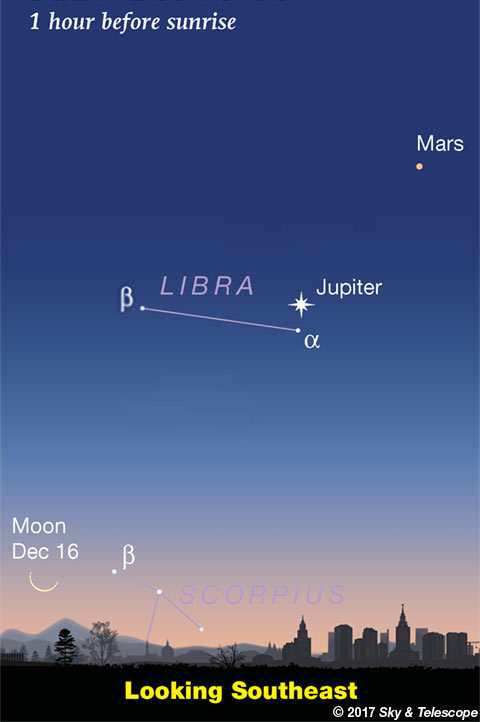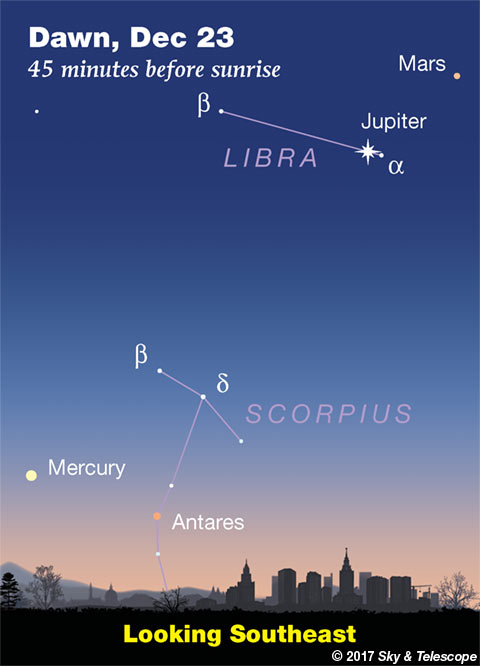Mother of all Geminids in a near-Earth pass. The asteroid 3200 Phaethon, source of the Geminid meteor shower now just past its peak, remains about 11th magnitude through December 17th: bright enough for medium-size telescopes. It's excellently placed high in the evening sky. See our article and finder charts.
Friday, December 15
• As the Summer Triangle sinks lower in the west, Altair is the first of its stars to go. Start by spotting bright Vega in the northwest right after dark. The brightest star above Vega is Deneb. Altair, the Triangle's third star, is farther to Vega's left or lower left. How late into the evening, and into the advancing season, can you keep it in view?


• As dawn begins to brighten on the morning of Saturday the 16th, look very low in the southeast to try to spot the thinning crescent Moon. It's far lower left of the diagonal line of Jupiter, Mars, and Spica (which is off the upper right edge here).
Saturday, December 16
• Have you ever watched a Sirius-rise? Find a spot with an open view right down to the east-southeast horizon, and watch for Sirius to come up about two fists at arm's length below Orion's vertical Belt. Sirius rises sometime around 8 p.m. now, depending on your location.
When a star is very low, it tends to twinkle quite slowly and often in vivid colors. Sirius is bright enough to show these effects well, especially with binoculars.
Sunday, December 17
• At this time of year the Big Dipper lies down lowest just after dark, due north. It's entirely below the north horizon if you're as far south as Miami. By 11 or midnight the Dipper wheels around to stand straight up on its handle, in fine view in the northeast.
Monday, December 18
• The Pleiades star cluster, the size of your fingertip at arm's length, shines very high in the southeast after dinnertime. How many Pleiads can you count with your unaided eye? Take your time and keep looking. Most people can count 6. With sharp eyesight, a dark sky, and a steady gaze, you may be able to make out 8 or 9.
• New Moon (exactly new at 1:30 a.m. on the 18th EST).
Tuesday, December 19
• The five brightest stars of Cassiopeia are usually called a W. At dusk the W stands nearly on end very high in the northeast. It soon turns over to become a flattened M even higher in the north. Explore Cassiopeia's telescopic jewels (there are many!) with Sue French's Deep-Sky Wonders article, chart, and photos in the December Sky & Telescope, page 55.
Wednesday, December 20
• This is the time of year when M31, the Andromeda Galaxy, passes your zenith soon after dark if you live in the mid-northern latitudes. The exact time depends on your longitude. Binoculars will show M31 just off the upraised knee of the Andromeda constellation's stick figure; see the big evening constellation chart in the center of Sky & Telescope.
• Algol, the prototype eclipsing binary star, shines at its minimum brightness, magnitude 3.4 instead of its usual 2.3, for about two hours centered on 11:11 p.m. EST (8:11 p.m. PST).
• You are remembered, Carl Sagan (November 9, 1934 – December 20, 1996).
Thursday, December 21
• Today is the shortest day of the year in the Northern Hemisphere, and the longest day in the Southern Hemisphere. The December solstice occurs at 11:28 a.m. EST, when the Sun reaches its southernmost declination for 2017 and begins its six-month return northward.
• The weak Ursid meteor shower should be at its peak tonight and/or tomorrow night. Its radiant (its perspective point of origin) is circumpolar, near Kochab at the bowl of the Little Dipper. So the shower is active to some degree from dusk to dawn. But, barring a rare outburst, you're likely to see only a few Ursids per hour of steady watching.
Friday, December 22
• This is the time of year when Orion shines in the east-southeast after dinnertime. He's well up now, but his three-star Belt is still nearly vertical. The Belt points up toward Aldebaran and, even higher, the Pleiades. In the other direction, it points down to where bright Sirius rises to twinkle furiously.
Saturday, December 23
• Sirius and Procyon in the balance. Sirius, the Dog Star, sparkles low in the east-southeast after dinnertime. Procyon, the Little Dog Star, shines in the east about two fist-widths at arm's length to Sirius's left. If you live around latitude 30° (Tijuana, New Orleans, Jacksonville), the two canine stars will be at the same height above your horizon soon after they rise. If you're north of that latitude, Procyon will be higher. If you're south of there, Sirius will be the higher one.
________________________
Want to become a better astronomer? Learn your way around the constellations! They're the key to locating everything fainter and deeper to hunt with binoculars or a telescope.
This is an outdoor nature hobby. For an easy-to-use constellation guide covering the whole evening sky, use the big monthly map in the center of each issue of Sky & Telescope, the essential guide to astronomy.

Once you get a telescope, to put it to good use you'll need a detailed, large-scale sky atlas (set of charts). The basic standard is the Pocket Sky Atlas (in either the original or Jumbo Edition), which shows stars to magnitude 7.6.
Next up is the larger and deeper Sky Atlas 2000.0, plotting stars to magnitude 8.5; nearly three times as many. The next up, once you know your way around, is the even larger Uranometria 2000.0 (stars to magnitude 9.75). And read how to use sky charts with a telescope.
You'll also want a good deep-sky guidebook, such as Sue French's Deep-Sky Wonders collection (which includes its own charts), Sky Atlas 2000.0 Companion by Strong and Sinnott, or the bigger Night Sky Observer's Guide by Kepple and Sanner.
Can a computerized telescope replace charts? Not for beginners, I don't think, and not on mounts and tripods that are less than top-quality mechanically (meaning heavy and expensive). And as Terence Dickinson and Alan Dyer say in their Backyard Astronomer's Guide, "A full appreciation of the universe cannot come without developing the skills to find things in the sky and understanding how the sky works. This knowledge comes only by spending time under the stars with star maps in hand."
This Week's Planet Roundup
Mercury begins to reappear in the dawn late this week, low in the southeast as shown above.
Venus and Saturn are out of sight, deeper in the glow of dawn.
Mars and Jupiter (magnitudes +1.6, and –1.7, respectively) rise in the east-southeast around 3 a.m. to 4 a.m. First up is Mars, glowing to the lower right of twinklier, bluer Spica. Then Jupiter, much brighter, rises to Mars's lower left. By early dawn they're well up in the southeast.
The gap between Mars and Jupiter is closing: from 10° on the morning of December 16th to 6½° on the 23rd. They'll have a close conjunction, 0.3° apart, on the mornings of January 6th and 7th.
Jupiter this week is passing less than 1° from 3rd-magnitude Alpha (α) Librae, a very wide double star for binoculars.
Uranus (magnitude 5.7, in Pisces) and Neptune (magnitude 7.9, in Aquarius) are in the southern sky right after dark. Use our finder charts online or in the October Sky & Telescope, page 50.
______________________
All descriptions that relate to your horizon — including the words up, down, right, and left — are written for the world's mid-northern latitudes. Descriptions that also depend on longitude (mainly Moon positions) are for North America.
Eastern Standard Time (EST) is Universal Time (also called UT, UTC, GMT, or Z time) minus 5 hours.
______________________
"Science is built up of facts, as a house is with stones. But a collection of facts is no more a science than a heap of stones is a house."
— Henri Poincaré (1854–1912)
______________________
"The dangers of not thinking clearly are much greater now than ever before. It's not that there's something new in our way of thinking, it's that credulous and confused thinking can be much more lethal in ways it was never before."
— Carl Sagan, 1996
______________________
"Objective reality exists. Facts are often determinable. Vaccines save lives. Carbon dioxide warms the globe. Bacteria evolve to thwart antibiotics, because evolution. Science and reason are not fake news, not a political conspiracy. Civilization's survival depends on our ability, and willingness, to use them."
— Alan MacRobert, your Sky at a Glance editor
______________________
"Facts are stubborn things."
— John Adams, 1770
 0
0








Comments
You must be logged in to post a comment.